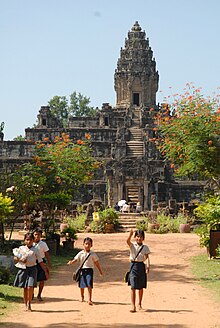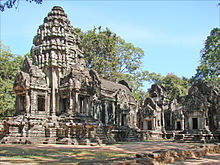Jayavarman II — the founder of Angkor[edit]
According to Sdok Kok Thom inscription,[4]:97[5]:353–354 circa 781 Indrapura was the first capital of Jayavarman II, located in Banteay Prei Nokor, near today's Kompong Cham.[6] After he eventually returned to his home, the former kingdom of Chenla, he quickly built up his influence, conquered a series of competing kings, and in 790 became king of a kingdom called "Kambuja" by the Khmer. He then moved his court northwest to Mahendraparvata, far inland north from the great lake of Tonle Sap.
Jayavarman II (802-835)[7]:xiii,59 is widely regarded as a king who set the foundations of the Angkor period in Cambodian history, beginning with a grandiose consecration ritual that he conducted in 802 on the sacred Mount Mahendraparvata, now known as Phnom Kulen, to celebrate the independence of Kambuja from Javanese dominion.[8] At that ceremony Prince Jayavarman II was proclaimed a universal monarch (Cambodian: Kamraten jagad ta Raja) or God King (Sanskrit: Deva Raja). He declared himself Chakravartin, in a ritual taken from the Indian-Hindu tradition. Thereby he not only became the divinely appointed and therefore uncontested ruler, but also simultaneously declared the independence of his kingdom from Java. According to some sources, Jayavarman II had resided for some time in Java during the reign of Sailendras, or "The Lords of Mountains", hence the concept of Deva Raja or God King was ostensibly imported from Java.[4]:99–101 At that time, Sailendras allegedly ruled over Java, Sumatra, the Malay Peninsula and parts of Cambodia,[9] around the Mekong delta.
The first pieces of information on Jayavarman II came from the K.235 stone inscription on a stele in Sdok Kok Thom temple, Isan region, dating to 1053. it recounts two and a half centuries of service that members of the temple's founding family provided for the Khmer court, mainly as chief chaplains of the Shaivite Hindu religion.[10]
According to an older established interpretation, Jayavarman II was supposed to be a prince who lived at the court of Sailendra in Java and brought back to his home the art and culture of the Javanese Sailendran court to Cambodia.[4]:97 This classical theory was revisited by modern scholars, such as Claude Jacques[11] and Michael Vickery, who noted that Khmer called chvea the Chams, their close neighbours.[12] Moreover, Jayavarman's political career began at Vyadhapura (probably Banteay Prei Nokor) in eastern Cambodia, which makes more probable long time contacts with them (even skirmishes, as the inscription suggests) than a long stay in distant Java.[13] Finally, many early temples on Phnom Kulen shows both Cham (e.g. Prasat Damrei Krap) and Javanese influences (e.g. the primitive "temple-mountain" of Aram Rong Cen and Prasat Thmar Dap), even if their asymmetric distribution seems typically khmer.[14]
In the following years he extended his territory and eventually, later in his reign, he moved from Mahendraparvata and established his new capital of Hariharalaya near the modern Cambodian town of Rolous.[4]:98 He thereby laid the foundation of Angkor, which was to arise some 15 km to the northwest. Jayavarman II died in the year 835[7]:59 and he was succeeded by his son Jayavarman III.[4]:103[15]Jayavarman III died in 877 and was succeeded by Indravarman I.[4]:110
The successors of Jayavarman II continually extended the territory of Kambuja. Indravarman I (reigned 877 – 889) managed to expand the kingdom without wars, and he began extensive building projects, thanks to the wealth gained through trade and agriculture. Foremost were the temple of Preah Ko and irrigation works. Indravarman I developed Hariharalaya further by constructing Bakong[5]:354–358 circa 881.[4]:110–111 Bakong in particular bears striking similarity to the Borobudur temple in Java, which strongly suggests that it served as the prototype for Bakong. There must have been exchanges of travellers, if not missions, between the Khmer kingdom and the Sailendras in Java, transmitting to Cambodia not only ideas, but also technical and architectural details.[16]
Yasodharapura — the first city of Angkor[edit]
Indravarman I was followed by his son Yasovarman I (reigned 889 – 915), who established a new capital, Yasodharapura – the first city of Angkor. The city's central temple was built on Phnom Bakheng, a hill which rises around 60 m above the plain on which Angkor sits. Under Yasovarman I the East Baray was also created, a massive water reservoir of 7.1 by 1.7 km.[4]:111–114[5]:358,360–361
At the beginning of the 10th century the kingdom split. Jayavarman IV established a new capital at Koh Ker, some 100 km northeast of Angkor, called Lingapura.[5]:360,363 Only with Rajendravarman II (reigned 944 – 968) was the royal palace returned to Yasodharapura. He took up again the extensive building schemes of the earlier kings and established a series of temples in the Angkor area, not the least being the East Mebon, on an island in the middle of the East Baray, and several Buddhist temples, such as Pre Rup, and monasteries.[5]:363–367 In 950, the first war took place between Kambuja and the kingdom of Champa to the east (in the modern central Vietnam).[4]:114–117
The son of Rajendravarman II, Jayavarman V, reigned from 968 to 1001. After he had established himself as the new king over the other princes, his rule was a largely peaceful period, marked by prosperity and a cultural flowering. He established a new capital slightly west of his father's and named it Jayendranagari; its state temple, Ta Keo, was to the south. At the court of Jayavarman V lived philosophers, scholars, and artists. New temples were also established: the most important of these are Banteay Srei, considered one of the most beautiful and artistic of Angkor, and Ta Keo, the first temple of Angkor built completely of sandstone.[4]:117–118[5]:367
A decade of conflict followed the death of Jayavarman V. Three kings reigned simultaneously as antagonists until Suryavarman I (reigned 1006 – 1050) gained the throne.[4]:134–135 Suryavarman I established diplomatic relations with the Chola dynasty of south India.[17] Suryavarman I sent a chariot as a present to the Chola Emperor Rajaraja Chola I.[18] His rule was marked by repeated attempts by his opponents to overthrow him and by military conquests. Suryavarman was successful in taking control of the Khmer capital city of Angkor Wat.[19] At the same time, Angkor Wat came into conflict with the Tambralinga kingdom of the Malay peninsula.[19][20] In other words, there was a three-way conflict in mainland Southeast Asia. After surviving several invasions from his enemies, Suryavarman requested aid from the powerful Chola Emperor Rajendra Chola I of the Chola dynasty against the Tambralinga kingdom.[19][21][22] After learning of Suryavarman's alliance with Rajendra Chola, the Tambralinga kingdom requested aid from the Srivijaya King Sangrama Vijayatungavarman.[19][20] This eventually led to the Chola Empire coming into conflict with the Srivijiya Empire. The war ended with a victory for the Chola dynasty and of the Khmer Empire, and major losses for the Sri Vijaya Empire and the Tambralinga kingdom.[19][20] This alliance also had religious nuance, since both Chola and Khmer empire were Hindu Shivaist, while Tambralinga and Srivijaya were Mahayana Buddhist. There is some indication that before or after these incidents Suryavarman I sent a gift, a chariot, to Rajendra Chola I to possibly facilitate trade or an alliance.[4]:136[23] Suryavarman I's wife was Viralakshmi, and following his death in 1050, he was succeeded by Udayadityavarman II, who built the Baphuon and West Baray.[4]:135,137–138 In 1074, conflict arose between Harshavarman III and the Champa King Harivarman IV.[4]:152







No comments:
Post a Comment